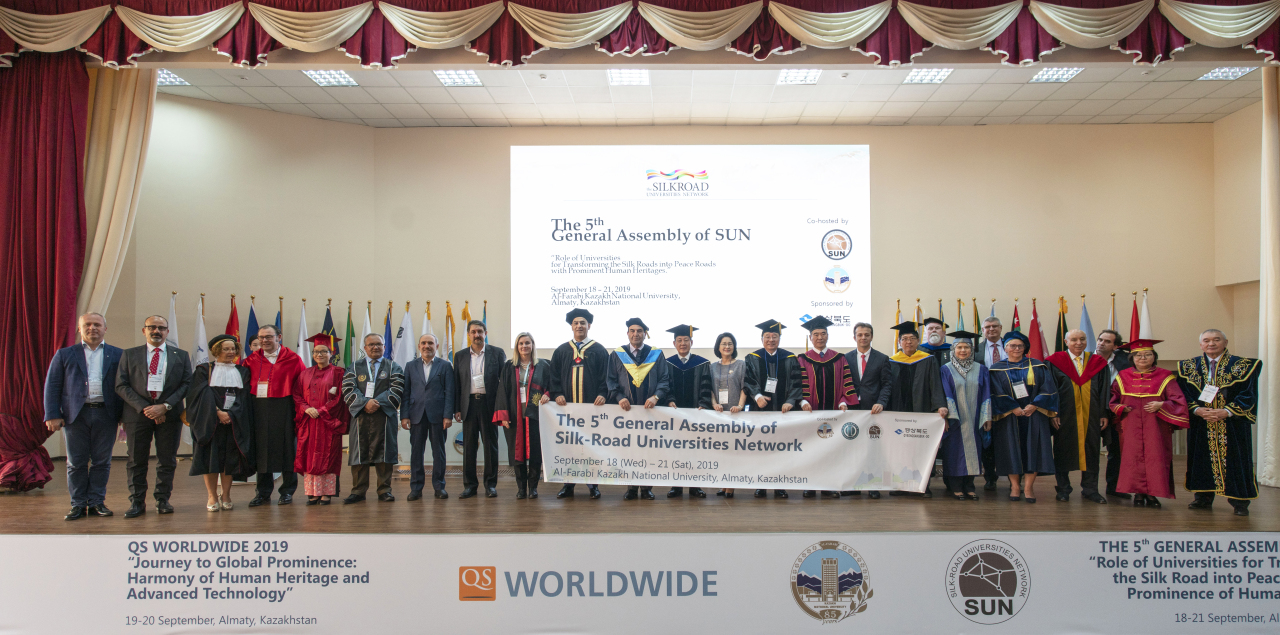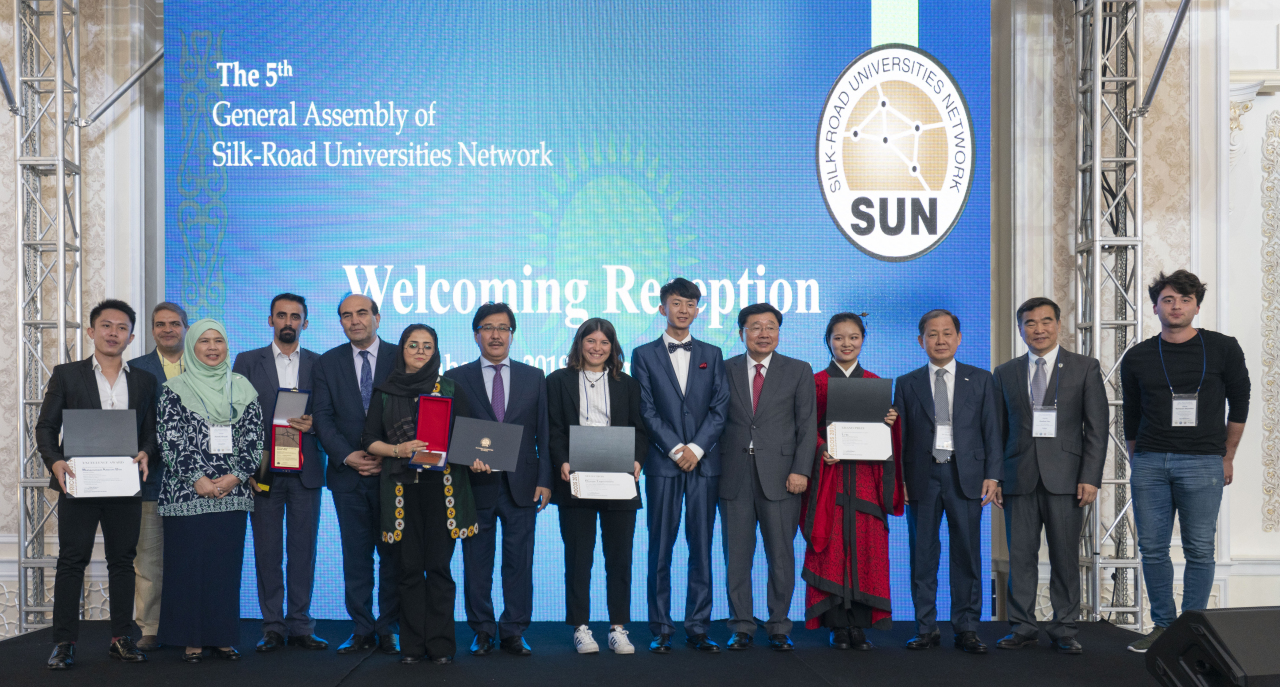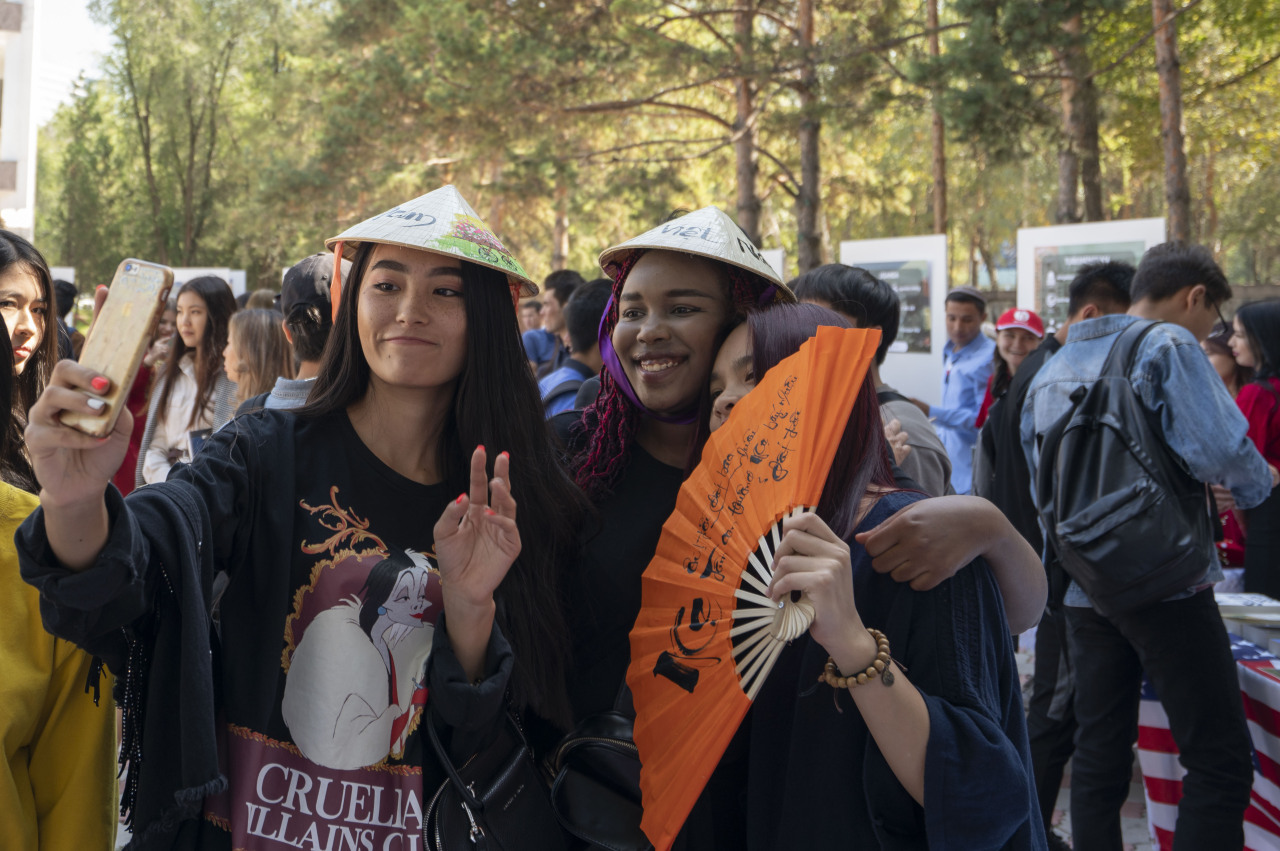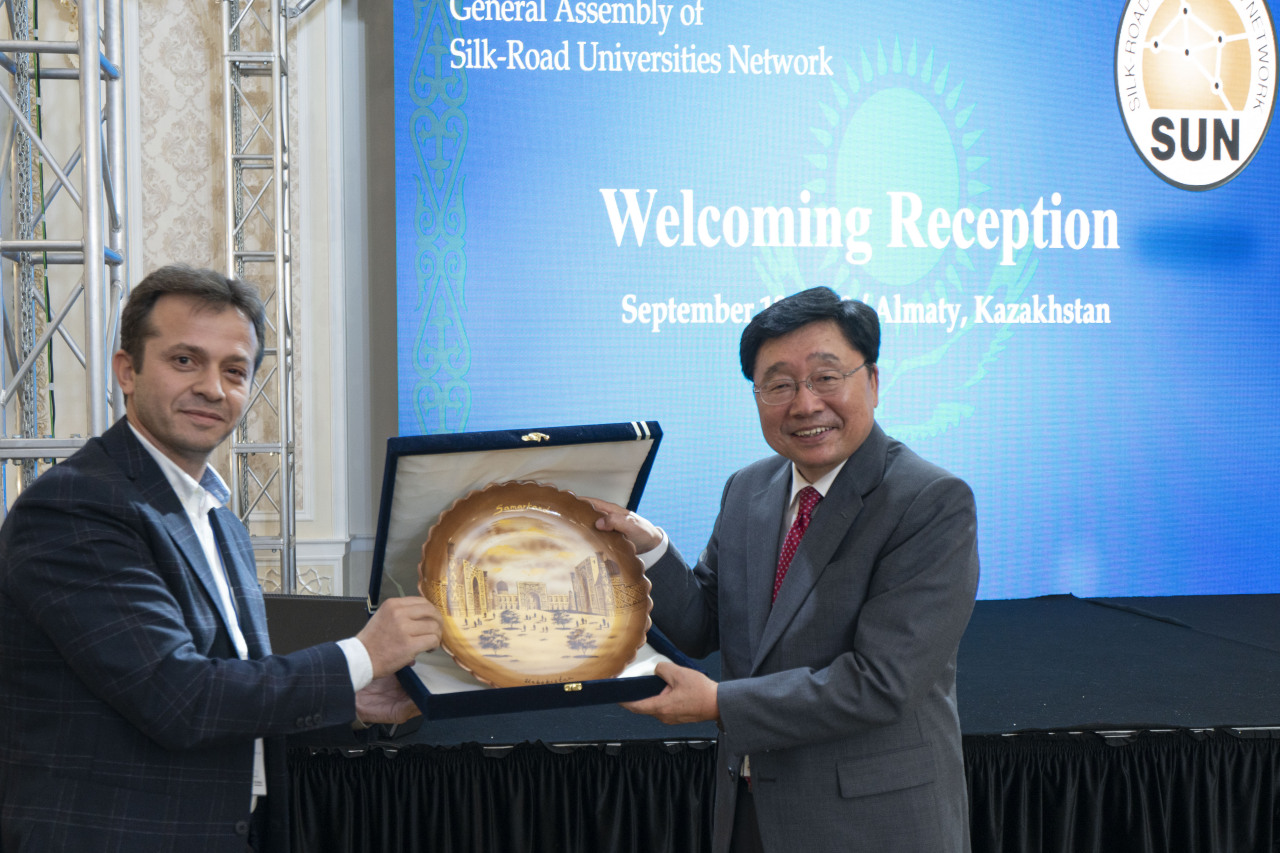Gyeongju certified as a key Silk Road city
Universities’ network recognizes Korean city as part of the ancient route
By Korea HeraldPublished : Sept. 27, 2019 - 09:57
ALMATY, Kazakhstan -- The heads of a group of universities located on the Silk Road have certified that the Korean city of Gyeongju which was the capital of the Silla Kingdom was part of the ancient trade routes that connected the East and West.
The certification was authorized by university presidents, rectors and chancellors and their deputies who participated in the fifth General Assembly of the Silk Road Universities Network held in Almaty, Kazakhstan, Sept. 18-21.
The certification was authorized by university presidents, rectors and chancellors and their deputies who participated in the fifth General Assembly of the Silk Road Universities Network held in Almaty, Kazakhstan, Sept. 18-21.

The certificate of recognition signed by the participants in the annual meeting of the SUN, an alliance of 81 major universities in 28 countries, will soon be delivered to Governor Lee Cheol-woo of Gyeongsangbuk-do which embraces Gyeongju.
The certificate noted that there are ample historical documents, diverse archeological findings and cultural heritages that showed the Silla Kingdom (57 BC- AD 935) which flourished in Gyeongsangbuk-do maintained economic, diplomatic and cultural relationships with countries like China and Japan in the East and other Silk Road countries such as India and Persia.
“Hence, we are hereby glad to recognize that Gyeongju City which was the capital of Silla Kingdom and the Gyeongsangbuk-do to be called “an important Silk Road city” and “an important “Silk Road province,” respectively, having significant relevance to the history of the Silk Road,” the certificate said.

The SUN, created five years ago to promote universities’ role in reviving the spirit of the ancient Silk Road and contribute to peace and trans-border interactions and prosperity along the routes, also included the designation of Gyeongju and two more Korean cities as Silk Road sites in the “Almaty Manifesto,” which the general assembly participants approved unanimously.
The manifesto, primarily designed to clarify the definition and value of the Silk Road, assess their reality and emphasize the commitment of the SUN to promote cooperation of member universities and revive the ancient routes as “peace roads,” challenged the myth that the Silk Road was limited to routes between Rome and China.
“Even as a trade route, the roads making up the Silk Road stretch far west from Rome, to the cities and towns of Portugal, England and even the Scandinavian Peninsula,” the manifesto said.
“To the east, it runs through China and Mongolia to many large and small cities and towns on the Korean Peninsula, including Seoul, Pyongyang and Gyeongju, and those in Japan,” It said. The trade route also embraced countries in the West Asia like Turkey, Iran and Afghanistan and also those in the Central Asia such as Kazakhstan, Uzbekistan and Kyrgyzstan, all of which played the role of cultural and economic bridges between eastern and western parts of the Silk Road.
“It bears significance that the SUN, a coalition of prestigious higher education institutions located along the Silk Road, officially recognized the historical facts that Korea was an important corridor of the ancient routes that linked the East and West,” said SUN Secretary-General Hwang Sung-don.

The SUN certificate and manifesto are based on historical facts and findings. Scholars maintained that the Gyeongju area had numerous traces of exchanges along the land and maritime Silk Road routes.
Archaeological materials excavated in Gyeongju include the Roman-style glassware, some of which are believed to have been produced in the Mediterranean coast in the 4th-5th century. Also found in Korea are Persian-style metallic objects and carpets and jewels made in Tashkent and Samarkand, and flavors, herbs and spices that originated from the Arabian Peninsula and the Western world.
Hwang, a professor at Hankuk University of Foreign Studies in Seoul and a founding father of the university alliance, said that the SUN’s recognition of Korea’s presence in the Silk Road routes, especially Gyeongju, is part of the group’s initiative to make it an authority on historical assessment of the Silk Road cities and heritage.
“We plan to form a special committee to promote the program, one that is similar to the UNESCO World Heritage Committee, to assess and certify Silk Road-relevant cities and heritage, including knowledge and skills,” the secretary-general said.
He said that candidates for the SUN list of Silk Road cities and heritage will be nominated by the sixth general assembly to be convened in Ankara, Turkey, next year and the designation will be made by the 2021 general assembly in Ulaanbaatar, Mongolia.
Hwang and other participants in the Almaty meeting shared the view that the SUN certification of the Silk Road Cities and Heritage is one piece of evidence that the university alliance is successfully building up its coherence and reputation as a respected institution on the Silk Road and an organization that can contribute to the world peace and prosperity.
“The main purpose of and spirit of SUN is to embrace differences in language, race, religion and politics, which normally serves as a roadblock to understanding and working together,” said Kim In-chul, president of Hankuk University of Foreign Studies who chairs the SUN General Assembly. “Under the spirit of SUN, we can design an excellent model for global organizations seeking to create a better world,” Kim said.
The president of the Al-Farabi Kazakh National University, Galimkair Mutanov, a co-host of this year’s assembly, said that the Silk Road had been the cradle of civilizations that carried the values of peace and cooperation, openness and tolerance, mutual benefit, common gain and exchange of experience. “Our university supports SUN’s initiatives to serve the world through various projects that restore the historical value of the ancient Silk Road,” Mutanov said.
The general assembly endorsed nine new members, including two from Afghanistan -- Kabul University and Herat University -- and one from Iran – University of Guilan. The three universities received greater welcome in that currently their countries are some of the Silk Road corridors through which free passages are blocked for political reasons.
The chancellor of the Herat University, Abdullah Faiz, aptly pointed out that his university focuses on the study of conflict analysis and peace building, a discipline fit for universities in a country that has been going through political and military conflicts despite the fact that it had been a point of free passageway on the Silk Road. Faiz noted that Herat was one of the important cities of the Persian empire and a key distribution center of Silk Road, passage through which had been safe for all for centuries.
Secretary-General Hwang said that the inclusion of a university located in Herat, which lies on the ancient trade routes that link the Middle East and Central and South Asia, is symbolic of the SUN’s efforts to reconnect the routes parts of which had been severed in modern times.
In order to promote connectivity along the Silk Roads, the SUN plans to run a number of programs in the coming years, according to the secretary-general. They include language and culture immersion programs for students of SUN member universities, job fair for SUN students in Gyeongsangbuk-do, networking of medical institutions and a Silk Roads tourism convention.
These will be added to the host of existing annual programs such as student expeditions of the Silk Roads routes; the photo, writings and debate contests; and film festival and orchestra performance of students at SUN member universities, which the alliance call “the future owners of the Silk Roads.”

The Almaty Manifesto clarifies that the university network’s vision is making students, the future leaders, go beyond their own societies, religions and political ideologies and care about the pains and troubles of other people and countries.
“As the manifesto proclaims, our vision is to make sure all the land and sea routes in the Silk Roads are open to free and safe travels, which will not be possible without establishing peace in all the corridors,” Hwang said. The main actors in the endeavor should be the young generations, the future owners of the Silk Roads, he added.
By Chon Shi-yong
Chon Shi-yong, former managing editor and chief editorial writer of The Korea Herald, is adviser to the Silk Road Universities Network. He can be reached at sychon07@gmail.com – Ed.
-
Articles by Korea Herald











![[Today’s K-pop] BTS pop-up event to come to Seoul](http://res.heraldm.com/phpwas/restmb_idxmake.php?idx=644&simg=/content/image/2024/04/17/20240417050734_0.jpg&u=)





![[KH Explains] Hyundai's full hybrid edge to pay off amid slow transition to pure EVs](http://res.heraldm.com/phpwas/restmb_idxmake.php?idx=652&simg=/content/image/2024/04/18/20240418050645_0.jpg&u=20240419100350)

![[Today’s K-pop] Zico drops snippet of collaboration with Jennie](http://res.heraldm.com/phpwas/restmb_idxmake.php?idx=642&simg=/content/image/2024/04/18/20240418050702_0.jpg&u=)